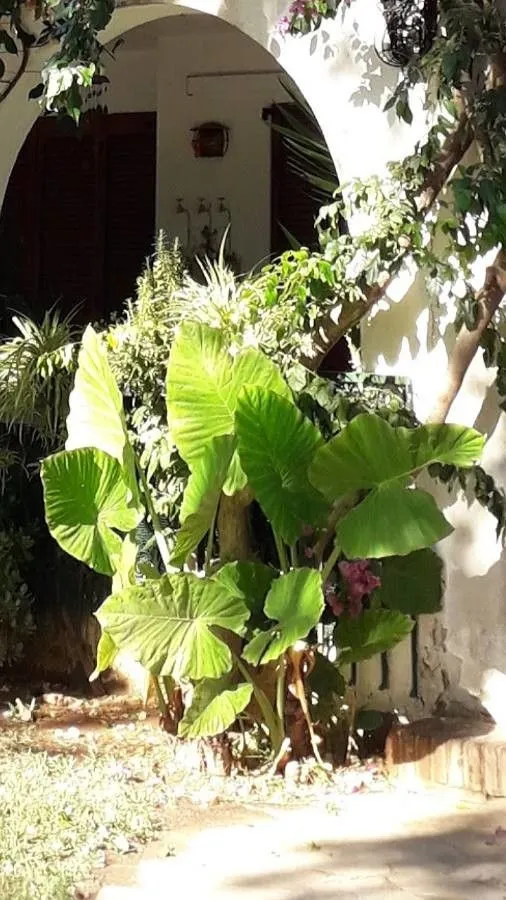
Author: Schott (L.)
Bibliography: H. Schott & S. L. Endlicher, Melet. bot. 18. 1832
Year: 1832
Status: accepted
Rank: species
Genus: Colocasia
Vegetable: True
Observations: India to S. China and Sumatera
Coco-yam, scientifically known as Colocasia esculenta, is a prominent plant species belonging to the family Araceae. This plant has a long history of cultivation and utilization across different regions, primarily from India to Southern China and Sumatera.
Colocasia esculenta is noted for its large, heart-shaped leaves that stand prominently on long, sturdy petioles. The plant is typically cultivated for its edible corms, which are rich in carbohydrates and serve as a staple food in many tropical and subtropical regions. These corms are not only nutritious but also versatile, lending themselves to a variety of culinary applications. They can be boiled, baked, or fried, and are often used in soups, stews, and even desserts.
In addition to its agricultural significance, Coco-yam plays a crucial role in traditional medicine and cultural practices. Various parts of the plant, including the leaves and corms, have been used in folk remedies to treat a range of ailments, from digestive issues to skin conditions.
The growing conditions for Colocasia esculenta require a warm and humid climate, with ample rainfall or irrigation to support its water-loving nature. It thrives in loamy, well-drained soils rich in organic matter. This adaptability has allowed it to spread and become naturalized in many regions outside its native range.
H. Schott & S. L. Endlicher, in their work “Melet. bot. 18” published in 1832, provided an essential bibliographic reference for understanding and classifying this species. Schott (L.), a renowned botanist, was instrumental in the scientific delineation of Colocasia esculenta, thus making significant contributions to the botanical community’s knowledge of this important plant.
Overall, Coco-yam stands out not just for its agricultural value but also for its cultural and medicinal importance, making it a vital species in many tropical and subtropical regions around the world.
En: Coco-Yam, Cocoyam, Dasheen, Taro, Eddo, Elephant’s-ear, Coco yam, Wild taro, Elephant Ears, Elephant’s ear, Kalo, Malanga
It: Aro d’Egitto, Fava d’Egitto, Pampini del Paradiso, Taro, Trombe del Paradiso
Eng: coco yam, cocoyam, dasheen, eddo, elephant’s-ear, taro, wild taro
Mlt: għorgħas
Deu: taro, zehrwurzel
Spa: alcocaz, colocasia, malanga, tayoba
Fra: colocasie
Msa: daun keladi
Por: inhame, inhame-branco, inhame-da-índia, inhame-roxo, taioba, taioba-de-são-tomé
Swe: taro
Nob: taro
Nno: taro
Vie: khoai sọ
Ar: Qolqas
Fr: Colocasie, Colocase comestible, Songe, Taro, Chou de chine
De: Zehrwurzel, Taro
Ko: Toran
Ms: Daun keladi
Mt: Għorgħas
Nb: Taro
Nn: Taro
Pt: Inhame, Inhame-branco, Inhame-da-índia, Inhame-roxo, Taioba, Taioba-de-são-tomé
Pt-br: Inhame, Inhame-branco, Inhame-da-África, Inhame-da-costa, Taioba-de-São-Tomé
Es: Malanga, Alcocaz, Colocasia, Tayoba, Bore, Nampi
Sv: Taro
Vi: Khoai sọ
Zu: Madumbe
Taken Aug 28, 2022 by Prasad Nayak (cc-by-sa)
Taken Jun 28, 2020 by Suzyy Q (cc-by-sa)
Taken Jun 28, 2020 by Suzyy Q (cc-by-sa)
Taken Nov 5, 2017 by jose (cc-by-sa)
Taken Jul 17, 2021 by josette Bagnaud (cc-by-sa)
Taken Nov 5, 2017 by jose (cc-by-sa)
Taken Nov 5, 2017 by jose (cc-by-sa)
Taken Nov 5, 2017 by jose (cc-by-sa)
© copyright of the Board of Trustees of the Royal Botanic Gardens, Kew.
© copyright of the Board of Trustees of the Royal Botanic Gardens, Kew.
© copyright of the Board of Trustees of the Royal Botanic Gardens, Kew.
Taken Oct 22, 2021 by piz tro (cc-by-sa)
Taken Nov 30, 2016 by Yves Demouy (cc-by-sa)
Taken Nov 5, 2017 by jose (cc-by-sa)
Taken Nov 5, 2017 by jose (cc-by-sa)
Taken Nov 5, 2017 by jose (cc-by-sa)
Taken Feb 18, 2015 by Andrew Gagg (cc-by-sa)
Taken Apr 7, 2021 by gilbert serveaux (cc-by-sa)
Taken Nov 30, 2021 by William Coville (cc-by-sa)
Taken Nov 30, 2016 by Yves Demouy (cc-by-sa)
Taken Feb 12, 2018 by Pep Secem (cc-by-sa)
Taken Sep 30, 2020 by gilles reant (cc-by-sa)
Taken Feb 20, 2019 by Dieter Albrecht (cc-by-sa)
Taken Oct 12, 2019 by Noëlle Dorion (cc-by-sa)
Taken Feb 20, 2019 by Dieter Albrecht (cc-by-sa)
Taken Jun 14, 2020 by Loday Lhawang (cc-by-sa)
Taken Dec 22, 2019 by Dieter Albrecht (cc-by-sa)
Taken Dec 23, 2020 by Jhansisri uttaravall (cc-by-sa)
Taken Jul 29, 2022 by Anatas (cc-by-sa)
Taken Sep 10, 2020 by anilkumar ayyappan (cc-by-sa)
Taken Dec 22, 2019 by Dieter Albrecht (cc-by-sa)
Taken May 31, 2020 by pauline leg (cc-by-sa)
Taken Jan 12, 2022 by Leslie Nava (cc-by-sa)
Taken Apr 21, 2021 by Vaibhav N (cc-by-sa)
Taken Apr 21, 2021 by Vaibhav N (cc-by-sa)
Taken Sep 12, 2019 by D Kari (cc-by-sa)
Growth habit: Forb/herb
Family: Myrtaceae Author: (F.Muell.) K.D.Hill & L.A.S.Johnson Bibliography: Telopea 6: 402 (1995) Year: 1995 Status:…
Family: Rubiaceae Author: Pierre ex A.Froehner Bibliography: Notizbl. Bot. Gart. Berlin-Dahlem 1: 237 (1897) Year:…
Family: Sapindaceae Author: Koidz. Bibliography: J. Coll. Sci. Imp. Univ. Tokyo 32(1): 38 (1911) Year:…
Family: Asteraceae Author: A.Gray Bibliography: Pacif. Railr. Rep.: 107 (1857) Year: 1857 Status: accepted Rank:…
Family: Fabaceae Author: Medik. Bibliography: Vorles. Churpfälz. Phys.-Ökon. Ges. 2: 398 (1787) Year: 1787 Status:…
Family: Aspleniaceae Author: (Cav.) Alston Bibliography: Bull. Misc. Inform. Kew 1932: 309 (1932) Year: 1932…